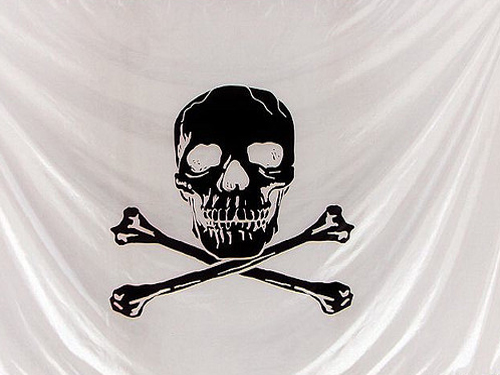Inside the pirate's code: hidden treasure

analysis Digital piracy for some isn't a crime: it's an art. Since the '80s, highly experienced groups of tech heads have been painstakingly copying legitimate content and distributing it among a close network of like-minded people. But, unlike what most people think, they don't want the general public to get their hands on it, and they hate sites like The Pirate Bay. For them, this is serious business, and one they don't want to share.

(Pirate's flag image by Ben Walther, CC BY-SA 2.0)
Piracy has become the scourge of the creative industries, accused of dissolving some US$50 billion a year in profits, according to pirate hunters the Business Software Alliance. Websites that contain pirated content are said to attract a whopping 53 billion visits per year and could be considered favourite haunts for Australians.
The pirated content, dubbed warez, are produced by a myriad of sources, but high-profile offerings are the product of specialist groups that remain hidden from most of the world. In fact, it is their practice of obfuscation and subterfuge that has kept them alive.
Few software products, if any, have resisted the attempts by coders and crackers to reverse engineer the complex and expensive anti-piracy measures designed to protect them. Companies such as Symantec, Adobe and Microsoft are in constant battle to kill pirate versions of their materials.
These specialist pirate groups, known by handles such as Razor1911, Diamond and Reloaded, operate in what they refer to as the "scene" — groups of similar users who compete to release the first and best versions of warez which are uploaded to hidden and tightly secured servers, known as "top sites", since they reside at the tip of the pirate chain.
The scene lacks a central leadership, yet strict rules apply. The most salient rule is that warez won't remain on a server unless they're the first or the best, but respect must be paid to a group-signed and updated charter that dictates file formats, release terminology and file sizes. Warez that do adhere to the charter, including duplicates and glitched releases, will be deleted, or "nuked".
The best top sites host warez in massive file servers that pirate investigators say are typically located in countries with slack copyright law.
It is ironically only through theft from these "top sites" that the scene's warez end up on the public pirate sites such as The Pirate Bay, although many groups and individuals outside of the scene release pirate material (generally of lower quality) directly to public sites.
It all started around 20 years ago, when copyright media was distributed over bulletin boards (BBSes) using painfully slow dial-up modems, or via post by so-called mail swappers. Later, others would host or steal file transfer protocol servers to distribute warez from the likes of Amiga, Commodore, Apple, Atari and a host of others.
A former pirate, known as Weezer, started as a mail swapper in 1988.
"I was a member of various international groups, started modem trading in about 1990, programmed BBS utilities and attended scene 'copy parties' here in England," Weezer said in an email. "We were worried about busts from the police, they did happen but were able to do little about them."
He said mail swappers typically used home addresses to ship pirate content, while advertisements promoting BBSes with warez had to have a home-line telephone number in order for users to connect. Also, distributing content over dial-up could be expensive.
"Being a trader was fairly expensive … 20 years ago it was pounds a minute," Weezer said. Others risked being caught to save money and used stolen calling cards with traceable phone numbers, while mail swappers reused stamps by covering them in clear tape and washing the ink off in a process called "stamp faking".
Now, outsiders spend a long time earning trust and building reputations to gain access to the scene groups. One user, going by the handle shad0wman, had spent years in Internet Relay Chats before becoming a so-called racer or courier, which is a title given to members wishing to access an FTP (file transfer protocol) server. They copy new warez titles, known as "pre(s)", over SSL (secure socket layer) encrypted links between FTP sites.
A group's mark (Screenshot by Darren Pauli/ZDNet Australia)
He claimed to be a support officer at a German university, a position he exploited by using the facility's high-capacity networks to funnel terabytes of warez data. Other racers also claimed to hold IT manager positions, which allowed them to use their knowledge and position to abuse the network.
But Shad0wman was kicked from the FTP sites after he quit his job and was unable to maintain the high upload ratios required to be a successful racer.
Pirate hunters, such as the Australian Federation Against Copyright Theft (AFACT), say they are aware of the groups and have forensic teams dedicated to tracking and prosecuting those involved, and have brought down some groups.
But AFACT admits it can be tough to crack: "They try and maintain an element of secrecy, and sometimes the individual key members only know each other by a nickname," AFACT director Neil Gane said.
"You want to go to the top of the pirate ecosystem to track those release groups responsible."